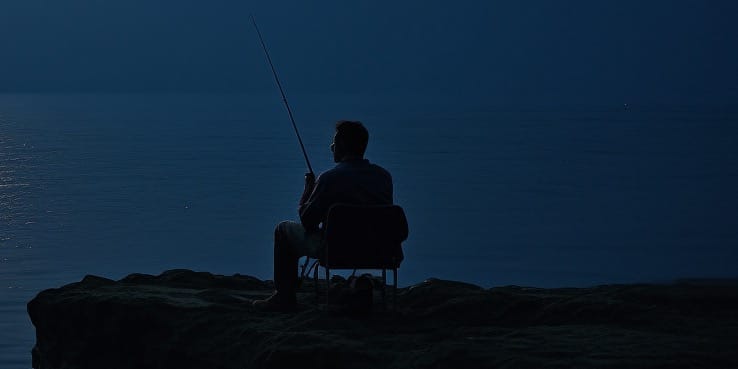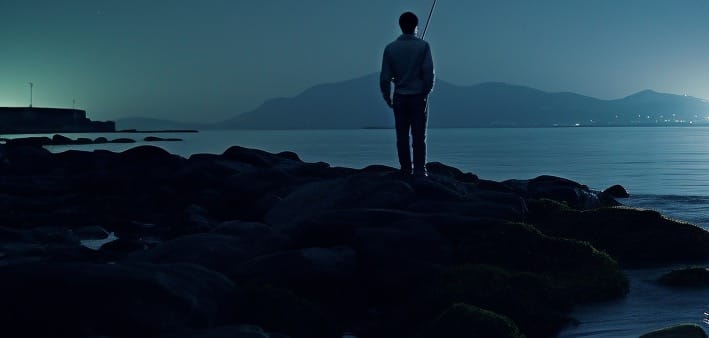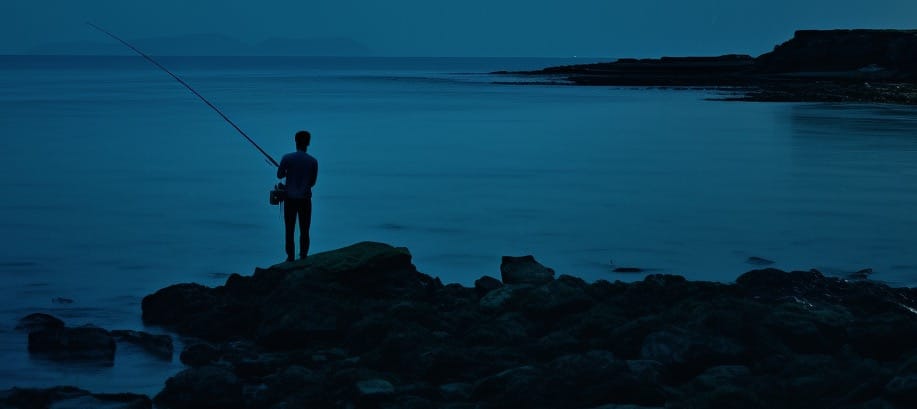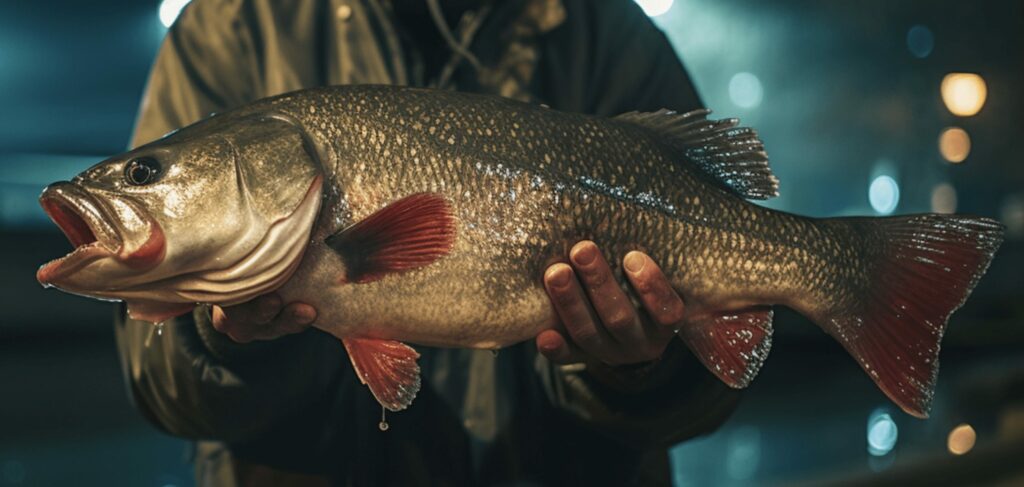The thrill of crappie fishing at night from the bank is an experience like no other.
I mean, standing on the shoreline, with the moon reflecting off the water, I feel a connection to nature that’s both profound and exhilarating.
The bank offers a unique vantage point, allowing me to observe the water’s surface and detect subtle movements. It’s a game of strategy and skill, and I’m here to share my knowledge with you.
But, fishing from the bank presents its own set of challenges and opportunities. Without the mobility of a boat, I’ve learned to read the water, understand the terrain, and use the bank’s natural features to my advantage. It’s a different kind of fishing, one that requires a keen eye and a strategic mind.
Are you looking for help to go after this unique fishing challenge?
Well, in this article, I’m gonna show you how I catch crappie from the bank when it happens to be dark.
Let’s get it going!
Understanding Crappie Behaviour At Night

Fishing for crappie from the bank at night is not just about the thrill of the catch; it’s a strategic and rewarding experience.
In that context, it’s essential to know how crappie behaves at night. Otherwise, how do you expect to successfully catch them?
Seasonal Behavior
- Spring: In spring, crappie are drawn to shallow bays with mucky bottoms that warm up quickly. They feed on minnows and shad, and both males and females are catchable from the shore. During the pre-spawn, they favor these warmer areas, and as the season progresses, they move onto harder bottoms to make their beds. Fishing from the bank during this time can be highly productive, especially if you focus on the north side of the lake where the sun warms the water faster.
- Summer: Summer brings a shift in crappie behavior. They are attracted to features like weeds, docks, rocks, and submerged timber. These structures provide shade and protection, making them ideal hunting grounds for crappie. Focus your efforts on these areas, especially during sunrise and sunset when crappie are actively patrolling for food. Casting from the bank to these structures can yield excellent results.
- Fall: Autumn is a time of abundance for crappie as they follow large schools of baitfish into shallow coves and backwater areas. If you find shad close to shore, you’re likely to find crappie. Fishing from the bank during this season requires keen observation and understanding of the crappie’s feeding patterns. Look for signs of shad activity near creek inlets and shallow coves, and you’ll be on your way to a successful catch.
- Winter: Winter presents its challenges, especially if you’re fishing in water that doesn’t freeze over. Crappie seek deeper water and structures like docks for food and warmth. Fishing from the bank requires patience and slow jigging techniques. Focus on marinas with access to docks that spread over deeper water, and remember, the key to winter crappie is to fish extremely slowly.
Night Fishing Advantages
Fishing for crappie at night from the bank offers unique advantages.
The stillness of the night, the reduced boat traffic, and the cooler temperatures create an environment where crappie are more active and approachable. The cover of darkness often brings crappie closer to the shore, making them more accessible from the bank.
Using the right lighting, whether it’s a lantern or specialized fishing lights, can attract baitfish, which in turn attracts crappie. Understanding how to leverage these nighttime conditions can turn an ordinary fishing trip into an extraordinary experience.
I mean, I’m a firm believer that from the bank, you can observe the water’s surface, detect subtle movements, and strategically place your bait to maximize your chances of success.
Fishing Techniques from the Shore
Different techniques work for different situations, and mastering them is key to successful crappie fishing from the bank.
- Vertical Jigging: This method works best in summer and winter near deeper weeds and under docks. Using very light line and small jig heads, you can entice crappie by mimicking their natural prey. It’s a slow and deliberate technique that requires patience and precision.
- Bobber Rig: My favorite way to fish lures for crappie, especially in spring, summer, and fall. By attaching a small float above your lure, you can gently move it along, creating a slow and enticing movement that crappie find irresistible.
- Cast/Retrieve: Effective under docks in summer, but remember, crappie like slow-moving baits. Casting your jigs far under docks and slowly reeling them in can be a highly effective method, but it requires practice and control.
- Live Bait: Using live bait like minnows, grasshoppers, or small crayfish is effective all year long. Crappie are particularly drawn to live bait, and fishing around docks, submerged wood, and under bridges can yield fantastic results.
Selecting the Right Bank
Location is more important than technique when it comes to catching crappie. Understanding the terrain and using the bank’s natural features to your advantage can make all the difference. Whether it’s a secluded cove with submerged trees or a bustling marina with abundant docks, choosing the right bank is the first step to a successful crappie fishing adventure at night.
Look for steeper banks with weeds, docks, and rocks as these locations attract large crappie close to the shore.
Here’s why:
- Weeds: Weeds provide cover and protection for crappie, allowing them to hide from predators and ambush their prey. They also host a variety of insects and small fish that crappie feed on. Fishing near weed beds from the bank can be highly productive, especially at night when crappie are more actively hunting.
- Docks: Docks offer shade and structure, creating ideal hiding spots for crappie. They often have submerged pilings and other underwater features that attract baitfish, which in turn attract crappie. Casting near docks from the bank, especially those extending over deeper water, can yield excellent results.
- Rocks: Rocky areas provide crappie with a place to rest and feed. Rocks often harbor algae and small organisms that attract minnows and other baitfish, making them prime feeding grounds for crappie. Fishing near rocky banks can be particularly effective, especially if you can identify areas where rocks transition into softer bottoms.
- Steep Banks: Steeper banks often lead to deeper water more quickly, providing crappie with easy access to both shallow feeding areas and deeper resting spots. These transitions between depths create natural pathways for crappie, and understanding how to fish these areas from the bank can be key to a successful catch.
- Submerged Trees: Submerged trees and other wooden structures provide crappie with cover and a place to spawn.
Tips For Crappie Fishing At Night From the Bank

Here are some tips I believe are essential to catch crappie at night form the shoreline:
- Choosing the Right Spot: You know, one of the most crucial parts of crappie fishing at night from the bank is finding that perfect spot. It’s not just about throwing your line anywhere; it’s about understanding where the crappie are likely to be. I always look for shorelines with deepwater access. Even if crappies go shallow in the spring, they still need that deep water close by. I’ve found that a mix of shallow brush or cover with fairly deep water within casting range is a winner. Oh, and a lantern can be your best friend, attracting shiners and other bait. But remember, patience is key; sometimes, the action doesn’t start until midnight.
- Outfitting Yourself Correctly: When I’m out on the bank, I make sure to have the right gear. A longer rod, at least 7 feet, helps with those longer casts, especially when the wind is playing tricks. And I can’t stress enough the importance of braided line. It’s strong, reliable, and perfect for crappies. Match it with a 6-pound monofilament leader, and you’re set. Trust me, the right outfit can make all the difference between a frustrating night and a successful haul.
- Keeping It Simple: I’ve learned over the years that sometimes, simplicity is key. Live bait, like minnows, can be a game-changer when bank fishing. A simple float rig with a light-wire long-shanked hook works wonders. But don’t shy away from artificial baits. A small twistertail on an 1/8-ounce jighead or a beetle spin has landed me many slabs. Experiment with different baits, but keep the setup simple. It’s all about what the crappie are biting, and sometimes, less is more.
- Wade Savvy: Wading is a technique that’s often overlooked but can be incredibly effective. On lakes with decent bottoms and flat shorelines with ample brush, wade-fishing has sometimes been even better than fishing from a boat for me. It’s silent, stealthy, and allows for perfect casts. Tube jigs tied directly to braided line without the use of a float have been my go-to. But remember, know the water before diving in, and only carry essential gear.
Here’s a cool video I found that shares with us a few valuable tips on how to fish at night for crappie:
Preparations Before Crappie Fishing At Night From the Bank
Preparing for crappie fishing at night from the bank is a multifaceted process. It’s about understanding the fish, having the right gear, ensuring safety, and cultivating the right mindset.
Selecting the Right Methods
Over the years, I’ve experimented with various methods to catch crappies from the shore. Vertical jigging, bobber rigs, casting and retrieving lures, and using live bait have all had their moments. The key is to match the method with the conditions and the crappie’s behavior. For example, vertical jigging near deeper weeds and under docks has been my go-to in summer and winter. Understanding which method to use and when has made all the difference.
Gearing Up
Preparing for a night of crappie fishing means having the right gear. From the right rod and line to the perfect bait, every detail matters. I’ve learned that a 7-foot rod is ideal for longer casts, and braided line matched with a 6-pound monofilament leader is incredibly strong. Live minnows or small twistertails on an 1/8-ounce jighead have been my favorite baits. Having the right gear not only increases the chances of success but also enhances the overall fishing experience.
Safety Considerations
Night fishing from the bank presents unique safety challenges. I always make sure to have proper lighting, not just for attracting fish but also for personal safety. Knowing the terrain, wearing appropriate footwear, and having a buddy along for the trip are all essential safety measures. Being aware of the surroundings and taking necessary precautions ensures a safe and enjoyable night of crappie fishing.
Mindset and Patience
Crappie fishing at night from the bank is as much about mindset and patience as it is about skill and technique. It’s about embracing the serenity of the night, connecting with nature, and enjoying the process. Sometimes the fish bite right away, and sometimes it takes hours. Being patient, observant, and in the right frame of mind has often been the key to my most memorable fishing nights.
Techniques For Crappie Fishing At Night From the Bank
Here are some techniques I gathered over the years based in my experience of fishing from the shoreline at night:
- Fishing Near Trees with Current: When I’m fishing along a river or creek bank, I always look for fallen trees, especially if there’s a good current pushing into them. Not every tree that fits these criteria will hold catchable crappie, but some will. I’ve learned to keep hitting trees until I find ones that hold crappie. Working my baits between the branches and limbs has been a great way to catch stream crappie.
- Fishing During the Spawn vs. Pre-Spawn: I’ve found that targeting pre-spawn crappie is more rewarding as they are focused on feeding. Spawning crappie are good to hit up, but they are more focused on spawning than eating. I look for these fish in mucky bottom bays, often on the northern shore of lakes, fishing among dense weed patches near the bank. In fact, I’d say that understanding the difference between spawn and pre-spawn crappie has helped me maximize my success.
- Downsizing Everything: When it comes to fishing from shore, I’ve learned that downsizing everything is essential. This means using lighter fishing line, ultralight rods, and smaller baits. I use 1 to 2-pound test mono, 1/32-ounce jig heads, and smaller tube jigs. Also, I slow down my fishing, as crappie near the bank will be wary of fishermen.
- Fishing Around Docks in Summer: During the summer nights, the first place I look for crappie is around docks. It’s a great place to fish for crappie both from the shore and standing on the dock itself. During the early morning and late afternoon, crappie will be adjacent to docks hunting. I’ve caught them with lures and live bait, and during midday, I cast my baits as far under the dock as I can.
Gear For Crappie Fishing At Night From The Bank

Fishing for crappie at night from the bank is more than just a rod and reel. It’s about having the right gear to enhance the experience and increase your chances of success. Let me share with you some of the essential gear that I always have with me when I’m out on the bank.
Castable Fish Finder
For ages, bank fishermen like me have been at a disadvantage when it comes to using fishing electronics. But now, we have castable fish finders that are comparable in quality to boat-mounted electronics. I use these devices to get an accurate picture of where the fish are.
Fan Casting
When I’m fishing from the shore with lures, I always cast at angles. I don’t just lazily cast directly out; instead, I cast my lures starting from nearshore, cutting the pie at around 30-degree angles. This technique allows me to cover more water and test different depths. It’s a methodical approach that has helped me find those elusive crappie hiding spots.
Bobber Rig
During the fall and winter, crappie need very slow motions, and that’s why I love using a bobber rig with my lures. The bobber forces me to fish slower, and it’s a technique that has caught me a lot of bank crappie. It’s a simple yet effective way to adapt to the crappie’s behavior during different seasons.
Now that we’ve covered the essential gear, let’s dive into some frequently asked questions about crappie fishing at night from the bank.
Frequently Asked Questions
1) What is the best bait for crappie fishing from the bank?
In my experience, the best bait for crappie fishing from the bank varies depending on the season and location. Live minnows are always a great choice, as they mimic the crappie’s natural prey. Soft plastic jigs in various colors, especially light pink and white, have also been highly effective for me.
2) How do you troll for crappie at night?
Trolling for crappie at night from the bank is a bit different than trolling from a boat. I usually set up multiple rods with different lures and depths, slowly walking along the bank and dragging the lines behind me. It’s a methodical approach that requires patience and attention to detail. Using glow-in-the-dark lures or adding a small glow stick near the lure can also enhance visibility and attract crappie.
3) What colors do crappie see best?
Crappie are known to respond to various colors, and I’ve found that light pink, white, red, green, light blue, and chartreuse are particularly effective. Two-toned lures with a combination of dark and light colors also work well. The key is to understand the water conditions and choose colors that provide good contrast and visibility.





